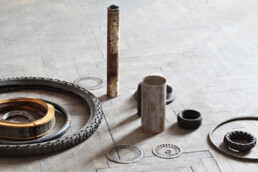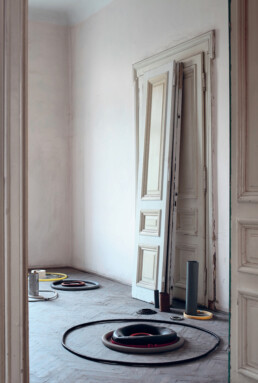VLATKA HORVAT (1974)
About Around
various materials and objects
variable dimensions
2012
After Tito, Tito
10 photographs of Tito’s official portraits, taken at the Atomic War Shelter in Konjic, Bosnia and Herzegovina
46 cm x 58 cm (10 psc)
edition: 2/5
2011–2013
About Around
various materials and objects
variable dimensions
2012
Vlatka Horvat prepared four works/installations for the needs of the 53rd October Salon: Door to Door, Fenced off Area, About Around and In Holes
A floor-based installation includes several groups or arrangements of found objects, in which smaller and smaller objects are placed one inside the other. All the objects that are used are loops, circles or ovals – placed on the floor and one inside the other, getting smaller and smaller as we move towards the centre of the arrangement they are a part of. The loops are either intact circular objects, or improvised structures made by joining pieces of string, cable and lines of materials. The act of inserting hollow and circular objects into one another blurs the distinct boundaries between the objects, as well as between the objects and the space they occupy. Exploring the idea of encompassment and the impossible ambition of attempting to encompass and grasp the physical world, the work plays with the issue of the way in which barriers mark the space and complicate the clear distinction between the place where one thing ends and the place where another begins. When the inside of an object becomes the outside of another, the spatial order is disrupted, and the negative space of a ‘hole’ is activated and eliminated at the same time. The unexpected provisional constellations and encounters of objects and materials taken from a variety of different contexts bring about a range of new associations, constructing surprising relationships and turning spatial hierarchies upside down.
Vlatka Horvat
© Cultural Centre of Belgrade, October Salon Collection and the artist
Gift Contract: III-5-292/26.9.2014.
Inventory No. 1359
Photo: installation view 53rd October Salon, Ana Kostić
After Tito, Tito
10 photographs of Tito’s official portraits, taken at the Atomic War Shelter in Konjic, Bosnia and Herzegovina
46 cm x 58 cm (10 psc)
edition: 2/5
2011–2013
In 2011, while working on a project in Tito’s bunker in Konjic, Vlatka photographed framed portraits of Tito, which were in the bunker, the same portraits she grew up with, as they hung on the walls of classrooms, offices, workplaces, train stations… She shot them through the glass of the frame, in the places where they still hung, finding angles at which the fluorescent lighting in the bunker was reflected in the glass in different ways. Thus, the light was interacting with the portrait itself – the face was melting, being disrupted, or simply hardly seen, which opened space for numerous associations formed as a result of the mentioned intervention. Depending on the angle of looking, the fluorescent light tubes sometimes appeared to be passing through Tito’s forehead, and emerging again from the back of his head. Or he would be so brightly lighted that it would produce the ‘sun-in-his-eyes’ effect, literally blinding him. In some other photographs, the light was passing across Tito’s neck, like a guillotine, separating his head from his torso and virtually decapitating him.
These real and found effects that she used (and that every visitor can experience on entering the bunker) interact with the viewer and add a dose of fiction into the portraits, giving them a new appearance and meaning. The light reflected in the glass of the portrait creates optical effects, obscuring, abstracting and compromising the image of Tito and his authoritative face, pointing to the fact that looking at any historical material would always be obstructed – by the present moment, the place where you are standing and from which you are looking. The title After Tito, Tito, taken from a slogan from the 1980’s in Yugoslavia, confronts the past with the present; confronts the historical Tito from the portraits with his contemporary mirror image, produced in the troubled space of waiting, contemplation and stasis of the Konjic bunker.
© Cultural Centre of Belgrade, October Salon Collection and the artist
Gift Contract: III-5-292/1/ 26.9.2014.
Inventory No. 1359
Photo: Courtesy of the artist, Milan Kralj
ABOUT THE AUTHOR:
Vlatka Horvat (1974, Čakovec, Croatia) works in various media – sculpture, performance, photography, video and works on paper. She has exhibited around the world, in different contexts and environments – museums, galleries, theatres, dance festivals, public spaces. She lives and works in London. A winner of the Rema Hort Mann Visual Arts Foundation Award (2011) More information at www.leavidakovic.com


